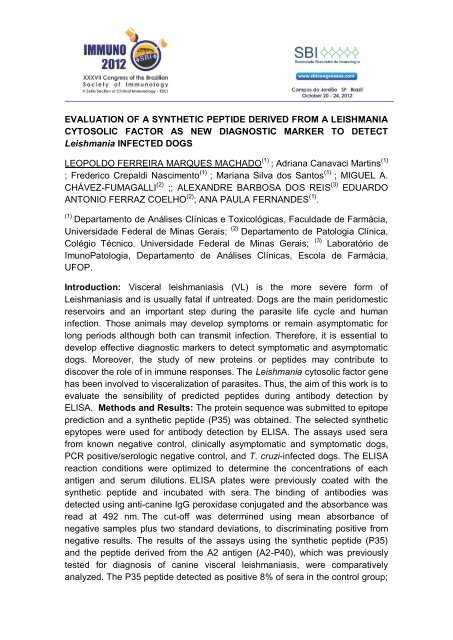immunology of infectious and parasitic diseases - XXXVII Congress ...
immunology of infectious and parasitic diseases - XXXVII Congress ...
immunology of infectious and parasitic diseases - XXXVII Congress ...
You also want an ePaper? Increase the reach of your titles
YUMPU automatically turns print PDFs into web optimized ePapers that Google loves.
EVALUATION OF A SYNTHETIC PEPTIDE DERIVED FROM A LEISHMANIA<br />
CYTOSOLIC FACTOR AS NEW DIAGNOSTIC MARKER TO DETECT<br />
Leishmania INFECTED DOGS<br />
LEOPOLDO FERREIRA MARQUES MACHADO (1) ; Adriana Canavaci Martins (1)<br />
; Frederico Crepaldi Nascimento (1) ; Mariana Silva dos Santos (1) ; MIGUEL A.<br />
CHÁVEZ-FUMAGALLI (2) ;; ALEXANDRE BARBOSA DOS REIS (3) EDUARDO<br />
ANTONIO FERRAZ COELHO (2) ; ANA PAULA FERNANDES (1) .<br />
(1) Departamento de Análises Clínicas e Toxicológicas, Faculdade de Farmácia,<br />
Universidade Federal de Minas Gerais; (2) Departamento de Patologia Clínica,<br />
Colégio Técnico. Universidade Federal de Minas Gerais; (3) Laboratório de<br />
ImunoPatologia, Departamento de Análises Clínicas, Escola de Farmácia,<br />
UFOP.<br />
Introduction: Visceral leishmaniasis (VL) is the more severe form <strong>of</strong><br />
Leishmaniasis <strong>and</strong> is usually fatal if untreated. Dogs are the main peridomestic<br />
reservoirs <strong>and</strong> an important step during the parasite life cycle <strong>and</strong> human<br />
infection. Those animals may develop symptoms or remain asymptomatic for<br />
long periods although both can transmit infection. Therefore, it is essential to<br />
develop effective diagnostic markers to detect symptomatic <strong>and</strong> asymptomatic<br />
dogs. Moreover, the study <strong>of</strong> new proteins or peptides may contribute to<br />
discover the role <strong>of</strong> in immune responses. The Leishmania cytosolic factor gene<br />
has been involved to visceralization <strong>of</strong> parasites. Thus, the aim <strong>of</strong> this work is to<br />
evaluate the sensibility <strong>of</strong> predicted peptides during antibody detection by<br />
ELISA. Methods <strong>and</strong> Results: The protein sequence was submitted to epitope<br />
prediction <strong>and</strong> a synthetic peptide (P35) was obtained. The selected synthetic<br />
epytopes were used for antibody detection by ELISA. The assays used sera<br />
from known negative control, clinically asymptomatic <strong>and</strong> symptomatic dogs,<br />
PCR positive/serologic negative control, <strong>and</strong> T. cruzi-infected dogs. The ELISA<br />
reaction conditions were optimized to determine the concentrations <strong>of</strong> each<br />
antigen <strong>and</strong> serum dilutions. ELISA plates were previously coated with the<br />
synthetic peptide <strong>and</strong> incubated with sera. The binding <strong>of</strong> antibodies was<br />
detected using anti-canine IgG peroxidase conjugated <strong>and</strong> the absorbance was<br />
read at 492 nm. The cut-<strong>of</strong>f was determined using mean absorbance <strong>of</strong><br />
negative samples plus two st<strong>and</strong>ard deviations, to discriminating positive from<br />
negative results. The results <strong>of</strong> the assays using the synthetic peptide (P35)<br />
<strong>and</strong> the peptide derived from the A2 antigen (A2-P40), which was previously<br />
tested for diagnosis <strong>of</strong> canine visceral leishmaniasis, were comparatively<br />
analyzed. The P35 peptide detected as positive 8% <strong>of</strong> sera in the control group;



